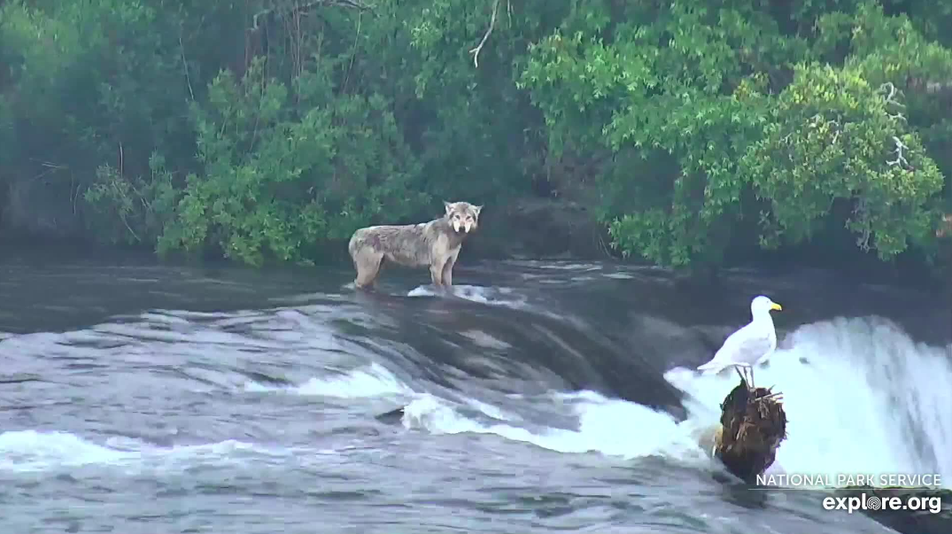Alaska’s Brooks River, home to the livestreaming bear cams, is the dominion of big, fat bears.
Yet early Saturday morning, when the waterfall where the bears feast was quiet, a gray wolf appeared on the cams and started pouncing on 4,500-calorie sockeye salmon. Bear cam viewers — who are global, devoted, and passionate documenters of all that happens on the explore.org cameras — watched the wolf snag and scarf bounties of fish.
“The bear cam viewers counted the wolf catching about 30 fish,” Mike Fitz, the resident naturalist for explore.org and a former park ranger at Katmai, told Mashable. “Without the cams we wouldn’t have known it.”
Wolves are spotted around Katmai National Park and Preserve, but Fitz had never seen a wolf fishing at the falls for a long time, in this case some three hours. Though a rare sighting there, a wolf exploiting a river teeming with salmon, without the immediate threat of bears, makes sense.
“Bears and wolves compete for many of the same resources,” explained Fitz.

The wolf at the Brooks River falls on July 5, 2020.

Hungry wolf on July 4, 2020.
In 2016, Katmai rangers spotted a bear sitting atop a moose carcass beside the one road in the park. When the bear eventually left, wolves appeared, apparently ravenous.
“They just eviscerated the moose carcass,” said Fitz.
Some Alaskan gray wolves eat lots of salmon, at times making up over half of their diet. One group of wolves, observed by biologists in Lake Clark National Park and Preserve, near Katmai, exploited the salmon run there each summer, but then switched to land-dwelling prey when the fish petered out.
“Katmai is a symbol of ecosystem health.”
Katmai is part of the Bristol Bay ecosystem, home to the largest run of sockeye salmon on the planet. Dense concentrations of fat bears thrive in the region, as protected lands and natural resources allow unimpeded salmon to spawn, lay eggs, and sustain enormous populations of fish.
The Trump administration, however, is weighing the potential construction of an unprecedented copper and gold mine in the area, replete with water treatment plants to discharge mine water into streams, a 188-mile-long natural gas pipeline to power the mine, pits for mud-like mining waste (known as tailings), roadways for trucking, and a brand new port to unload mined materials onto ships.
“It’s talking about turning a large part of Alaska into an industrial mining district,” Alaskan bear-viewing guide Drew Hamilton, who is the former assistant manager of Alaska’s bear-filled McNeil River State Game Sanctuary and Refuge, told Mashable last year.
Just impacting one section of the Bristol Bay watershed may have detrimental effects to the salmon populations on which the fat bears and gray wolves depend, recent research has shown.
For now, Katmai remains one of the last pure, untrammeled wilds left on Earth.
“Katmai is a symbol of ecosystem health,” said Fitz.
